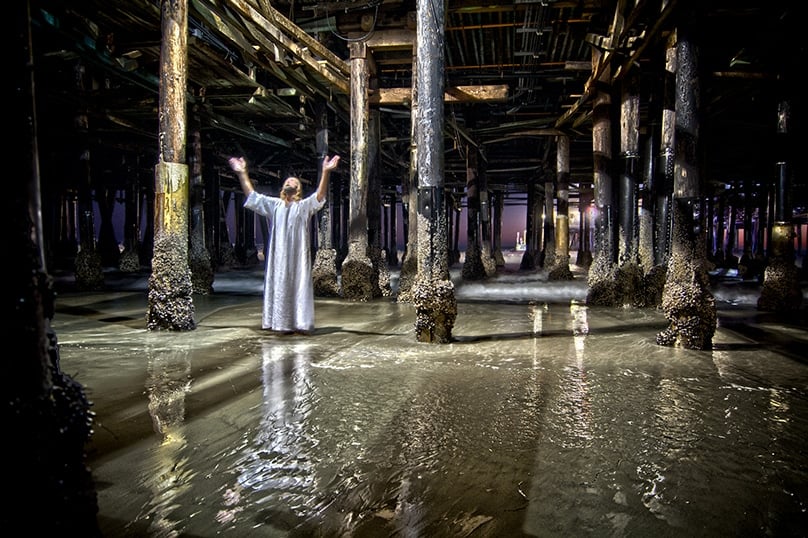
As a compulsive reader, I’ll forgive a mixed metaphor or two, if the material is interesting enough. You’re taking arms against a sea of troubles? Sure, why not. You protest that the proposed budget is “just ham-fisted salami-slicing by the bean counters”? I’m still with you, if only because I like ham and beans. You wish me to understand that Jesus is the Good Shepherd and simultaneously the lamb who was slain, who is a door and also a key who is the light of the world, while being a cornerstone who is the Word, who was with God, who is God, and servant, and king, and a new Adam, and a bridegroom?
And a baby?
And bread?
Well, slow down, son. Which is it? A new reader of the Gospel might be excused for thinking that, in the words of that poor beleaguered bulldog, “It just don’t add up!” If you can’t express what you’re saying in one, simple, sustained idea, then maybe you don’t really know what you’re talking about. Can we please figure out what this “Jesus” character is, once and for all, and stick with that?
Of course, the answer is that Jesus is all things to all men, not only in who He actually is, but in how He presents Himself to the world through scripture. And so the profusion of metaphors, similes, symbols and parables in the Bible is a feature, not a bug. When the Bible was written under the inspiration of the Holy Spirit, it was written so that there would be something for everyone, and something for each person at different stages in his life. The proliferation of titles is a sign of God’s bounty.
At various times in my life, I’ve read that Jesus is the light of the world, and that means almost nothing to me. But tell me that He is a rock, and oh, I will cling to Him. Or maybe the idea of Christ as bridegroom is troubling or unhelpful, but tell me that He is the Word, and I hear that. We need to have all kinds of ways of understanding Jesus, because we have all kinds of needs, and because there are all kinds of needy people in the world. The wealth of imagery surrounding Christ is a sign of His generosity, and not of His poor organisational skills.
And this wealth of imagery is something we must accept, even if it feels messy, or disorderly, or beyond what we can manage. At Mass this weekend, the bad thief who was crucified with Jesus did something to Christ besides insulting and taunting Him: He tried to limit him. Apparently willing to spend some of his last breaths in mockery and rage, the criminal shouts, “Are you not the Christ? Save yourself and us.”
Even the soldiers jeered at him.
As they approached to offer him wine they called out,
“If you are King of the Jews, save yourself.”
Above him there was an inscription that read,
“This is the King of the Jews.”
That’s pretty specific: The ones who executed him applied a literal paper label of identification to the specimen in question. “You are this, and it means you must do that.”
And what is wrong with trying to nail Him down like that, if He is who He says He is?
Well, there’s some consistent imagery for you: Nailing Jesus down. When we try to “nail” Jesus down, when we affix Him to the cross with a literal label hanging over His head, when we insist that He be who we want Him to be, to carry out some function for us, to be what we prefer and nothing else … that is what crucifies Him.
God, by definition, cannot be limited, unless He chooses to limit Himself. As He does when He says that He is a lamb, or a door, or a light. Or when He confines Himself to the tiny body of a newborn. Or when He – all of Him, body, blood, soul, and divinity – can be swallowed like a piece of bread. He may choose to limit Himself. We may not choose to limit Him.
It is a good thing to flee to Christ in whatever form He chooses to show Himself to us. If He says, “I am a door,” let us walk through. If He says, “I am the light,” let us turn to Him and see. If He says, “I am bread,” then let us eat. But let us not nail Him down to that one thing, like an insect onto a labelled card, just because we think we are entitled to receive that one thing.
Sometimes Christ says, “I am the way,” and when you try to follow Him, you find yourself alone in the world. Sometimes He says, “I will give you rest,” and when you accept, then the real work begins. Sometimes Christ says, “I am love,” and when you go to Him, the first thing you feel is a terrible pain.
Then what? What are we supposed to do then, when we are repelled or confused or hurt by these unexpected “mixed metaphors” of our encounters with a Christ who is all things?
The only thing to do is to respond like the second thief in Sunday’s Gospel.
The first thief tries to nail Christ down, to limit Him to one half of a narrow business contract, to demand his due. But the second thief simply begs, “Remember me when you come into your kingdom.” He doesn’t try to tell Christ who He is or what He must do. No one tells the king what to do. But we may remind Him that we are His subjects, and then trust Him as best we can. It’s not up to us. It’s up to Him, because Christ is king.
He may choose to limit Himself. We may not choose to limit Him.
